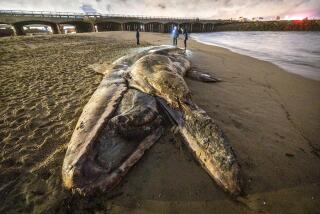Disease threatens critical population of gray bats
Federal biologists on Monday confirmed the presence of a lethal fungus known as white-nose syndrome at Alabama’s Fern Cave National Wildlife Refuge, home of the largest wintering colony of endangered gray bats.
With more than 1 million hibernating gray bats, Fern Cave is the most significant hibernaculum for the species. Documentation of the disease in its maze of chilly sinkholes and galleries “is extremely alarming and could be catastrophic,” said Paul McKenzie, endangered species coordinator for the U.S. Fish and Wildlife Service.
Gray bats are especially vulnerable to disturbance and the disease because they live in large colonies in only a few caves within a limited geographic range in the Southeastern U.S. The Fern Cave refuge, for example, consists of 199 acres of forested hillside underlain by a limestone cave complex.
The fungus turned up in samples taken from tri-colored bats, which also inhabit Fern Cave along with an estimated 1 million endangered Indiana bats.
The discovery is a setback for cooperative conservation measures, such as restricting human access to gray bat roosting sites, that had been successful in helping endangered bats recover in Fern Cave.
“White-nose syndrome is like a bazooka pointed at gray bats,” said Mollie Matteson, a bat specialist at the Center for Biological Diversity. “We could lose the entire species in a very short time, as well as a million Indiana bats.”
The deadly bat epidemic was discovered in New York in 2006 and has been confirmed in five Canadian provinces and 22 states as far west as Missouri. It has killed mostly little brown bats – one of the most common mammals in North America -- which have lost an estimated 20% of their population in the Northeast.
In January, federal authorities announced that white-nose syndrome had been found for the first time in Kentucky’s Mammoth Cave National Park, a popular historic site visited by about 400,000 people a year.
North America’s 25 species of hibernating bats have been hardest hit by the fungus, which scientists know as Geomyces destructans. But each of the 45 species of bats in the U.S. and Canada may be susceptible, wildlife biologists say. In addition, they say, there is no reason to believe that the disease won’t eventually make its way across the continent to California.
White-nose syndrome can be transmitted between animals through direct contact. It gets its name from the powdery, white substance that appears around muzzles, ears and wings of affected bats.
Bats with white-nose syndrome exhibit unusual behavior during cold winter months, including flying outside during the day and clustering near the entrances of caves and mines where they hibernate. Bats have been found sick and dying in unprecedented numbers near these hibernacula during a portion of the year when there are no insects to eat.
Bats feast on such night-flying insects as mosquitoes, which transmit West Nile virus, and agricultural pests damaging to cotton and corn crops. They also pollinate plants, including the saguaro cactus. A study published in Science estimates that the value of pest control provided by bats each year is at least $3.7 billion nationwide.
ALSO:
Jenna Jameson’s court date set in Newport Beach battery
Prosecutor urges jurors to convict fake Rockefeller of murder
Autopsy: Rick Warren’s son died of self-inflicted gunshot wound
More to Read
Start your day right
Sign up for Essential California for news, features and recommendations from the L.A. Times and beyond in your inbox six days a week.
You may occasionally receive promotional content from the Los Angeles Times.







